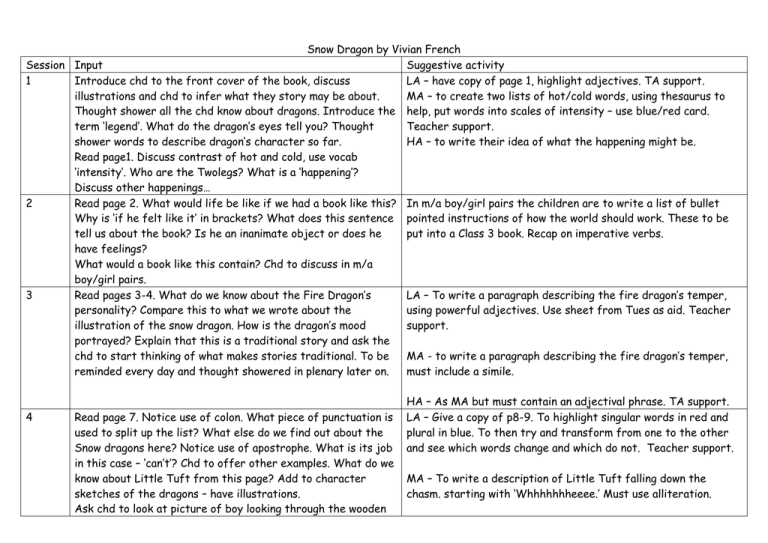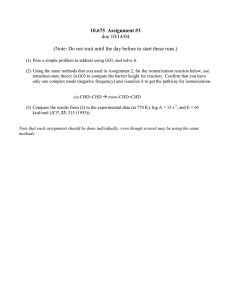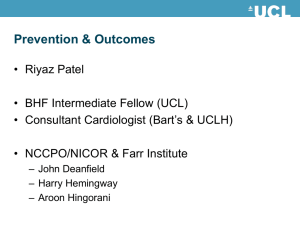Snow Dragon by Vivian French Session Input Suggestive activity
advertisement

Snow Dragon by Vivian French Session Input Suggestive activity 1 Introduce chd to the front cover of the book, discuss LA – have copy of page 1, highlight adjectives. TA support. illustrations and chd to infer what they story may be about. MA – to create two lists of hot/cold words, using thesaurus to Thought shower all the chd know about dragons. Introduce the help, put words into scales of intensity – use blue/red card. term ‘legend’. What do the dragon’s eyes tell you? Thought Teacher support. shower words to describe dragon’s character so far. HA – to write their idea of what the happening might be. Read page1. Discuss contrast of hot and cold, use vocab ‘intensity’. Who are the Twolegs? What is a ‘happening’? Discuss other happenings… 2 Read page 2. What would life be like if we had a book like this? In m/a boy/girl pairs the children are to write a list of bullet Why is ‘if he felt like it’ in brackets? What does this sentence pointed instructions of how the world should work. These to be tell us about the book? Is he an inanimate object or does he put into a Class 3 book. Recap on imperative verbs. have feelings? What would a book like this contain? Chd to discuss in m/a boy/girl pairs. 3 Read pages 3-4. What do we know about the Fire Dragon’s LA – To write a paragraph describing the fire dragon’s temper, personality? Compare this to what we wrote about the using powerful adjectives. Use sheet from Tues as aid. Teacher illustration of the snow dragon. How is the dragon’s mood support. portrayed? Explain that this is a traditional story and ask the chd to start thinking of what makes stories traditional. To be MA - to write a paragraph describing the fire dragon’s temper, reminded every day and thought showered in plenary later on. must include a simile. 4 Read page 7. Notice use of colon. What piece of punctuation is used to split up the list? What else do we find out about the Snow dragons here? Notice use of apostrophe. What is its job in this case – ‘can’t’? Chd to offer other examples. What do we know about Little Tuft from this page? Add to character sketches of the dragons – have illustrations. Ask chd to look at picture of boy looking through the wooden HA – As MA but must contain an adjectival phrase. TA support. LA – Give a copy of p8-9. To highlight singular words in red and plural in blue. To then try and transform from one to the other and see which words change and which do not. Teacher support. MA – To write a description of Little Tuft falling down the chasm. starting with ‘Whhhhhhheeee.’ Must use alliteration. 5 6 door. Ask them to shut their eyes and describe what they see. Read page 9-10. Discuss language used, incl. suffix –ness. Read pages 13-14. How do the illustrations suddenly change? Model looking up ‘encrusted’ in the dictionary. Note use of semi-colon and apostrophe. Discuss how settings have been used in the book so far. Look through illustrations to remind. Discuss. HA – As MA but concentrating on the setting that Little Tuft is in. Must also use commas for listing and repetition. TA support. LA – TA to read chd section of story with no punctuation. Chd to suggest where commas should go. MA – Give chd a copy of double page spread. In pairs chd to experiment deleting words to see if meaning is affected. Write a list of words which are essential and which are not. Is there a pattern? Teacher support. HA – Choose which age range this book is targeted at. Work in pairs to write a report on why this is the case, identifying particular… Independent. Read page 15-16. Discuss what we know about the snow dragon Starting with ‘Slowly she stretched herself…’ chd to write a already. Why was Little Tuft stuttering? Discuss why the snow description of the snow dragon. Use illustrations as a prompt. dragon doesn’t want to fight. How would you describe ‘Book’? LA/MA -to understand that they are writing in3rd person. st nd rd Discuss whether the book is written in 1 , 2 or 3 person. HA – to use ‘very, quite, more, most’ to add a degree of intensity Discuss which verbs illustrate this. to adverbs – if possible. 7 Pages 17-18. Model looking up ‘lulled’ in dictionary. Can chd offer any synonyms? Discuss relevance of ‘happy ever after’. Do the chd agree with Book?? Discuss conventions of speech. Ask chd to collect their thoughts on why this is a traditional story. Give Y3 M/A pairs a choice of familiar stories to look at beginnings and endings. Think about both the story itself and any interesting sentences that start or end a story. Y4 to compare a range of settings in stories. Which are their favourites and why? Could they use these in their story writing? Make a note in literacy books to refer back to. 8 Show pages 19-20 but do not read text. Discuss layout of pages. What style are they in. Do you enjoy reading stories laid out like this? Why? What do you think might be happening by looking at the illustrations? Give chd A3 page in this style. Give lines for text, leave blank for illustrations. Chd to write their own version of what might have happened when Book flew away. Perhaps Books arrival to the fire dragon… how could he stop it becoming a happy ending? 9 10 11 12 Put up page 21 with words eliminated (hurtling, hissing, spikes, turrets). Do we need these words for the paragraph to make sense? What might these words be? Ask for suggestions. Explain to the chd that there is a key theme to this book. By looking at the p21-22 illustration can they see what this might be? Give examples of other themes…ask chd to think of ‘Hare and the tortoise.’ Read pages 23-26 What happened to the snow dragon? Who has seen faces or animals in the clouds? What sort of ending does this book have? Is that common of traditional stories? Then read pages 27-28. How does this page about the book leave things? Look back at the notes made as a class about the four characters. How do the chd feel about each of the characters? Get chd to stand in places around the room according to their feelings. Discuss. TA S&L assess. Discuss the story as a class. Chd to say what they liked and to justify their reasons. Ask the chd what they would like to know about the book in a review. Collate a list of questions. Challenge a child to put the main events into a sequence with less than 12 statements. HA to understand the importance of the setting in relation to mood and using detail. Encourage chd to use typical traditional story language. Shared write of the snow dragon going into the volcano to defeat the fire dragons. Start with, ’She was flying directly towards the volcano.’ Expect alliteration, powerful verbs, how the characters are feeling. Chd to write their own version, using the story as a guide/model. LA to have a model to fill in the missing words. HA – give chd copy of pages 25-26 with no punctuation. Chd to rewrite and to add commas, connectives or full stops wherever they deem it appropriate. Share with a partner. Which worked better and why? Teacher support. MA (Independent) and LA (TA support) – give a copy of 25-26. Chd to identify adjectives and either remove them or change them to note affect on meaning. Write individual sentences which impressed the chd. Y3 – chd to write a letter to a friend explaining one of the characters’ behaviour and characteristics. TA support for LA – have model for letter. Y4 – Chd to create poster to illustrate how The Snow Dragon uses settings to portray the character’s characteristics and behaviour. Half do fire, half snow. To use words and pictures… describe both characteristics and to draw/describe the settings in detail. Y3: Chd are to create a map using illustrations and text to show the journey through the story. Use A3 paper. Y4: to write a review of the snow dragon targeted at y2 chd. Use the questions collated as a class. Write in detail, using extracts from the text. 13 Planning and draft 1: Explain to the chd that they are going to write a traditional story based on ‘The snow dragon’. Show them a picture of the world, with good on one half, evil on the other and the neutral people stuck in the middle. Use the idea that the neutral people need help from the good against the evil. HA to use an inanimate object as a ‘middleman’. Explain that they can use dragons BUT not to copy the original story. Can be a mythical creature or animals, as these are often used in traditional stories.





